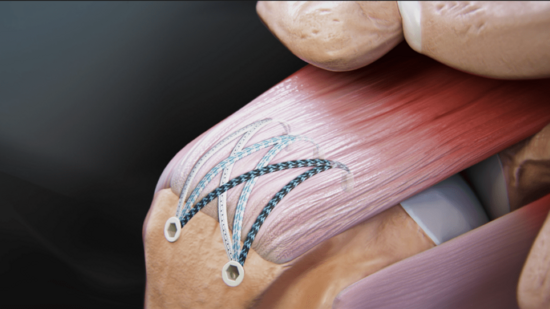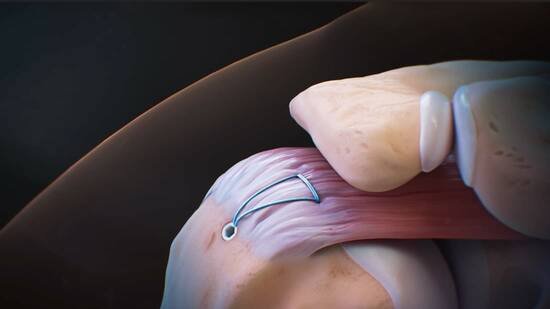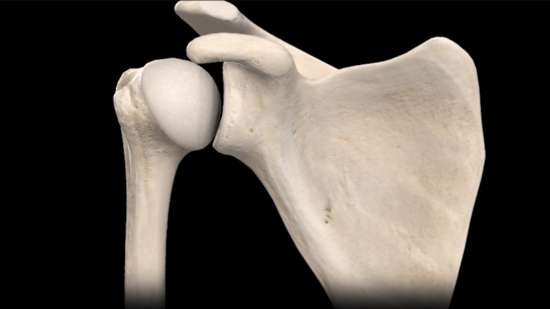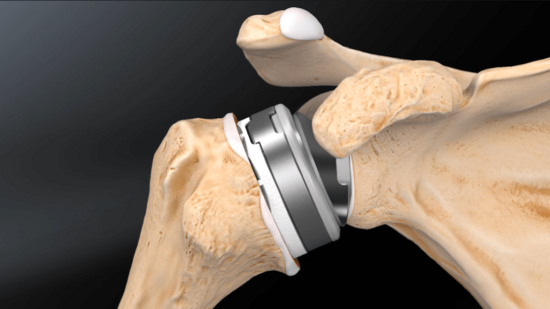Shoulder
The shoulder is the body’s most flexible joint, featuring a ball-and-socket design that enables the arm to move in various directions. This range of motion is essential for both daily tasks and physical activity.
Rotator Cuff
What is a Rotator Cuff Tear?
Causes, symptoms, and diagnosis
The four rotator cuff muscles are attached to the upper arm bone by their tendons. Injury to the arm or gradual wear and tear can damage these tendons and cause them to tear away from the bone. When this happens, it is difficult and painful for the rotator cuff muscles to move and stabilize the arm, which can impact many daily activities.
The rotator cuff muscles surround and stabilize the shoulder joint. Rotator cuff tears result when the tendons of these muscles are torn from the upper arm bone. This can occur with sudden injuries or develop slowly from wear and tear over time, leading to pain and decreased shoulder motion.
Rotator Cuff Tear Treatment
With and without surgery
Depending on several factors, the severity of a rotator cuff tear will determine the best treatment option. Physical therapy and pain-relieving methods are often tried first. Ongoing injuries that continue to cause a lot of pain may need surgery to repair the rotator cuff tear.
Rotator Cuff Tear Surgery
Rotator cuff repair is a surgery that reattaches the torn rotator cuff tendon back to the upper arm bone. This can help improve the ability of the rotator cuff muscles to function properly. If a rotator cuff tear cannot be repaired, other procedures are available to improve the stability of the shoulder.
Rotator cuff repair is performed using shoulder arthroscopy. This minimally invasive technique uses small incisions, a camera, and small instruments to reattach the torn rotator cuff tendon to the upper arm bone.
Shoulder Arthritis
Shoulder arthritis results from the loss of cartilage in the shoulder joint. This causes pain and stiffness within the shoulder, which can affect daily tasks like getting dressed, reaching, and lifting the arms.
What is Shoulder Arthritis?
Causes, symptoms, and diagnosis
Shoulder arthritis occurs when the cartilage that lines the shoulder joint wears down over time. This cartilage allows for smooth and pain-free movement of the shoulder. As that cartilage wears away, it results in friction, leading to pain and stiffness of the shoulder.
Shoulder Arthritis Treatment
With and without surgery
Physical therapy and pain-relieving methods can help manage symptoms of shoulder arthritis. But if pain continues to limit daily activities, surgery may be an option.
Shoulder Arthritis Surgery
When nonsurgical management does not provide effective pain relief for shoulder arthritis, shoulder joint replacement is the recommended surgical option. This surgery replaces the ends of the ball and socket of the shoulder joint with metal and plastic implants. This can be accomplished with either a total shoulder replacement or reverse shoulder replacement.
During shoulder replacement surgery, the surgeon makes an incision along the front of the shoulder to access the surfaces of the shoulder joint. Advances in shoulder surgery involve smaller implants and less time in the operating room.
Collarbone Fractures (Clavicle Fractures)
A broken collarbone, or clavicle fracture, is a break in the small, thin bone located in the front of the body near the shoulder. Collarbone fractures typically result from falls or high-impact injuries.
What is a Clavicle Fracture?
Causes, symptoms, and diagnosis
Collarbone fractures most often affect the middle of the collarbone. X-rays help determine if surgical or nonsurgical treatment is needed.
Clavicle Fracture Treatment
With and without surgery
Proper alignment of the collarbone is needed for a fracture to heal. The type of fracture will help determine which treatment is best. Some collarbone fractures will heal on their own when the shoulder and arm are immobilized by wearing a shoulder sling, while others may require surgery.
Clavicle Fracture Surgery
A metal plate, screws, and sometimes a suture implant can be used to hold a broken collarbone in place to stabilize a fracture.
Inflammation of the biceps tendon is known as biceps tendinitis. It usually develops from overuse over time. Biceps tendinitis often occurs with another shoulder injury, like a rotator cuff tear or labral tear.
Bicep Tendinitis
What is Biceps Tendinitis?
Causes, symptoms, and diagnosis
Biceps tendinitis results in pain felt at the front of the shoulder. Patients may also notice weakness in the arm. A thorough evaluation by a health care provider will help determine a diagnosis, and if there are any other shoulder problems.
Biceps Tendinitis Treatment
With and without surgery
Treatment for biceps tendinitis will vary from patient to patient. Rest and strengthening exercises for the shoulder may help. But if pain continues, surgery may be needed.
Biceps Tendinitis Surgery
Biceps tenodesis is a surgery for biceps tendinitis. A surgeon will cut the biceps tendon and reattach it elsewhere on the upper arm with an anchor or metal button. This can help reduce strain on the biceps tendon.
Advances in shoulder surgery allow a biceps tenodesis to be completed using arthroscopy, a minimally invasive procedure that uses a camera and small instruments to reattach the tendon to the upper arm bone.















